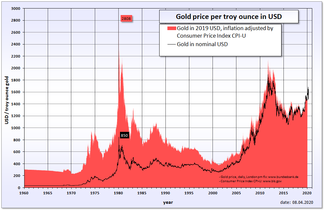Silver Thursday
Silver Thursday was an event that occurred in the United States silver commodity markets on Thursday, March 27, 1980, following the attempt by brothers Nelson Bunker Hunt, William Herbert Hunt and Lamar Hunt to corner the silver market. A subsequent steep fall in silver prices led to panic on commodity and futures exchanges.


Background
Nelson Bunker Hunt, Lamar Hunt, and William Herbert Hunt, the sons of Texas oil billionaire Haroldson Lafayette Hunt, Jr., had for some time been attempting to corner the market in silver. In 1979, the price for silver (based on the London Fix) jumped from $6.08 per troy ounce ($0.195/g) on January 1, 1979, to a record high of $49.45 per troy ounce ($1.590/g) on January 18, 1980, an increase of 713%. The brothers were estimated to hold one third of the entire world supply of silver (other than that held by governments). The situation for other prospective purchasers of silver was so dire that on March 26, 1980, the jeweller Tiffany's took out a full page ad in The New York Times, condemning the Hunt Brothers and stating "We think it is unconscionable for anyone to hoard several billion, yes billion, dollars' worth of silver and thus drive the price up so high that others must pay artificially high prices for articles made of silver".[1]
But on January 7, 1980, in response to the Hunts' accumulation, the exchange rules regarding leverage were changed, when COMEX adopted "Silver Rule 7" placing heavy restrictions on the purchase of commodities on margin. The Hunt brothers had borrowed heavily to finance their purchases, and, as the price began to fall again, dropping over 50% in just four days, they were unable to meet their obligations, causing panic in the markets.
Climax
The Hunt brothers had invested heavily in futures contracts through several brokers, including the brokerage firm Bache Halsey Stuart Shields, later Prudential-Bache Securities and Prudential Securities. When the price of silver dropped below their minimum margin requirement, they were issued a margin call for $100 million. The Hunts were unable to meet the margin call, and, with the brothers facing a potential $1.7 billion loss, the ensuing panic was felt in the financial markets in general, as well as commodities and futures. Many government officials feared that if the Hunts were unable to meet their debts, some large Wall Street brokerage firms and banks might collapse.[2]
To save the situation, a consortium of US banks provided a $1.1 billion line of credit to the brothers which allowed them to pay Bache which, in turn, survived the ordeal. The U.S. Securities and Exchange Commission (SEC) later launched an investigation into the Hunt brothers, who had failed to disclose that they in fact held a 6.5% stake in Bache.[3]
Stock market reaction
This day marked the end of a large stock market correction that year.
Aftermath
The Hunts lost over a billion dollars through this incident, but the family fortunes survived. They pledged most of their assets, including their stake in Placid Oil, as collateral for the rescue loan package they obtained. However, the value of their assets (mainly holdings in oil, sugar, and real estate) declined steadily during the 1980s, and their estimated net wealth declined from $5 billion in 1980 to less than $1 billion in 1988.[4]
In 1988, the brothers were found responsible for civil charges of conspiracy to corner the market in silver. They were ordered to pay $134 million in compensation to a Peruvian mineral company that had lost money as a result of their actions. This forced the brothers to declare bankruptcy, in one of the biggest such filings in Texas history.[5]
See also
Notes
- "He Has a Passion for Silver". TIME Magazine. April 7, 1980. Retrieved August 6, 2009.
- "Bunker's Busted Silver Bubble". TIME Magazine. May 12, 1980. Retrieved August 6, 2009.
- "The Hunts are on the Hunt". TIME Magazine. April 14, 1980. Retrieved August 6, 2009.
- "Big Bill for a Bullion Binge". TIME Magazine. August 29, 1989. Retrieved August 6, 2009.
- "Billionaire Bankrupts". TIME Magazine. October 3, 1988. Retrieved August 6, 2009.
Further reading
- Fay, Stephen (1982). Great Silver Bubble. ISBN 978-0-340-33033-3
- Jerry W. Markham (2002) A financial history of the United States: From the age of derivatives into the new millennium : (1970–2001), , volume 3, M.E. Sharpe, ISBN 978-0-7656-0730-0